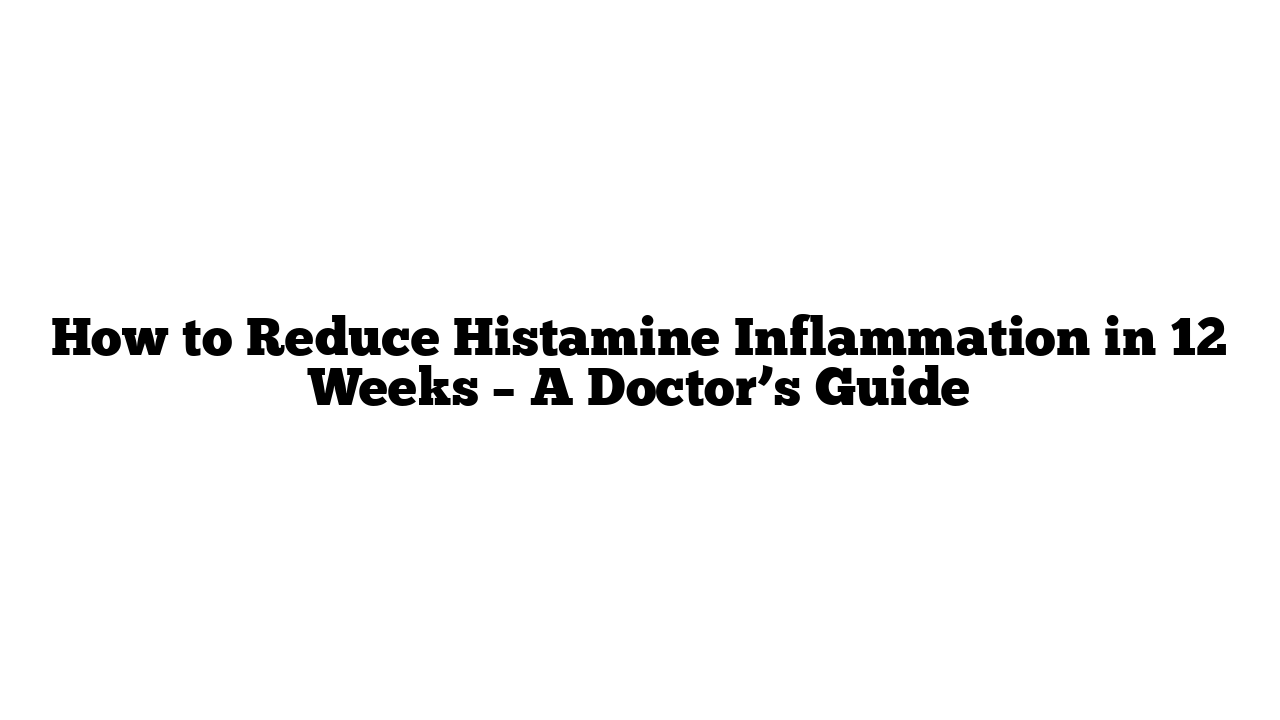Histamine is a compound that plays an important role in many of our body’s functions. However, when it accumulates in excess, it can lead to a variety of unpleasant symptoms. These can range from allergies and digestive discomfort to more serious conditions like headaches, anxiety, and even joint pain. If you’re struggling with histamine-related inflammation, you might be wondering how to manage or reduce it effectively. In this article, we’ll discuss how histamine affects the body and explore three primary interventions you can take to reduce histamine inflammation within 12 weeks.
What is Histamine and How Does It Affect Your Body?
Histamine is a natural compound produced by the immune system. It acts as a signaling molecule, helping to regulate various functions, especially in the brain, skin, and digestive system. When histamine is released into the bloodstream, it causes inflammation, which is part of the body’s immune response. While we need a certain amount of histamine to stay healthy, too much histamine can trigger a wide range of symptoms, including:
- Headaches
- Hives and skin irritation
- Itchy eyes and runny nose (similar to allergy symptoms)
- Joint pain and stiffness
- Digestive disturbances
- Fatigue
- Anxiety and mood swings
If you’ve been experiencing these symptoms, it may be time to look at your histamine load and find ways to reduce it.
Three Key Steps to Reduce Histamine Load
1. Remove High Histamine Triggering Foods
One of the first steps in reducing histamine inflammation is cutting out foods that are high in histamine. Foods like aged cheeses, fermented foods, processed meats, and alcohol are common offenders. While it may feel difficult to avoid these foods, especially if they’re a regular part of your diet, removing them can significantly reduce your histamine load.
To make this easier, there are many reputable online resources available—some universities even provide histamine food lists, ranking foods on a scale of low to high histamine content. Look for these resources, and aim to limit high histamine foods to reduce the amount of histamine entering your body.
2. Support Your Body’s Histamine Elimination Pathways
Your body has several biochemical pathways that help process and eliminate histamine. Supporting these pathways can reduce the load of histamine in your system. There are three primary pathways to focus on:
- Acetylation Pathway: This pathway is supported by Vitamin B5 (pantothenic acid). Vitamin B5 can be extremely helpful in breaking down histamine and providing relief, especially for people with histamine intolerance. You can easily find Vitamin B5 in foods like avocados, sunflower seeds, and whole grains.
- DAO (Diamine Oxidase) Pathway: The DAO enzyme is responsible for breaking down histamine in your digestive tract. Supporting this enzyme can help lower histamine levels. You can boost DAO activity by taking Vitamin C, Vitamin B6, and Magnesium. Foods like bell peppers, citrus fruits, and dark leafy greens are good sources of these nutrients.
- Methylation Pathway: The HMNT pathway is a longer and more complex pathway, but it is essential for processing histamine efficiently. Supporting methylation involves methyl donors like methylated B vitamins (such as Methyl B12 and Methylfolate), Vitamin B6, Magnesium, and Niacinamide (Vitamin B3). These nutrients help prevent histamine buildup and assist in the detoxification process.
By supporting all three pathways, your body can more efficiently eliminate excess histamine.
3. Understand and Remove Triggers Beyond Food
While food plays a significant role in histamine buildup, other factors can trigger the release of histamine in your body. These include:
- Mast Cell Activation Syndrome (MCAS): This condition occurs when the body’s mast cells, which are responsible for releasing histamine, become overly sensitive and release histamine prematurely.
- Chronic Infections: Long-term infections can trigger inflammation, leading to increased histamine levels.
- Gut Imbalance: Poor digestion and an unhealthy microbiome in the gut can cause histamine release. This is why addressing gut health is crucial in managing histamine inflammation.
- Toxicities and Environmental Factors: Exposure to certain toxins, chemicals, or environmental pollutants can also lead to increased histamine production.
If you’re dealing with chronic health issues or inflammation, it may be necessary to work with a healthcare professional to address underlying causes like chronic infections, gut health, or mast cell activation.
Can Supplements Help?
For those struggling with histamine intolerance or related symptoms, supplements may provide additional support. Some supplements, like DAO (Diamine Oxidase) and Vitamin B5, have been shown to be helpful for supporting histamine breakdown and reducing symptoms. A high-quality supplement from reputable brands, like Seeking Health, may also provide relief.
While supplements can be useful, it’s important to work with a healthcare provider to determine the right approach for your specific needs.
Wrapping Up: A 12-Week Plan to Manage Histamine Inflammation
Reducing histamine inflammation in 12 weeks is achievable with the right approach. By removing high histamine foods, supporting histamine elimination pathways, and addressing triggers beyond food, you can experience significant improvement. Remember that histamine intolerance can be complex, so consulting a healthcare provider for personalized guidance is always a good idea.
Taking small, consistent steps over the next 12 weeks can make a big difference in reducing your histamine levels and improving your overall health.
